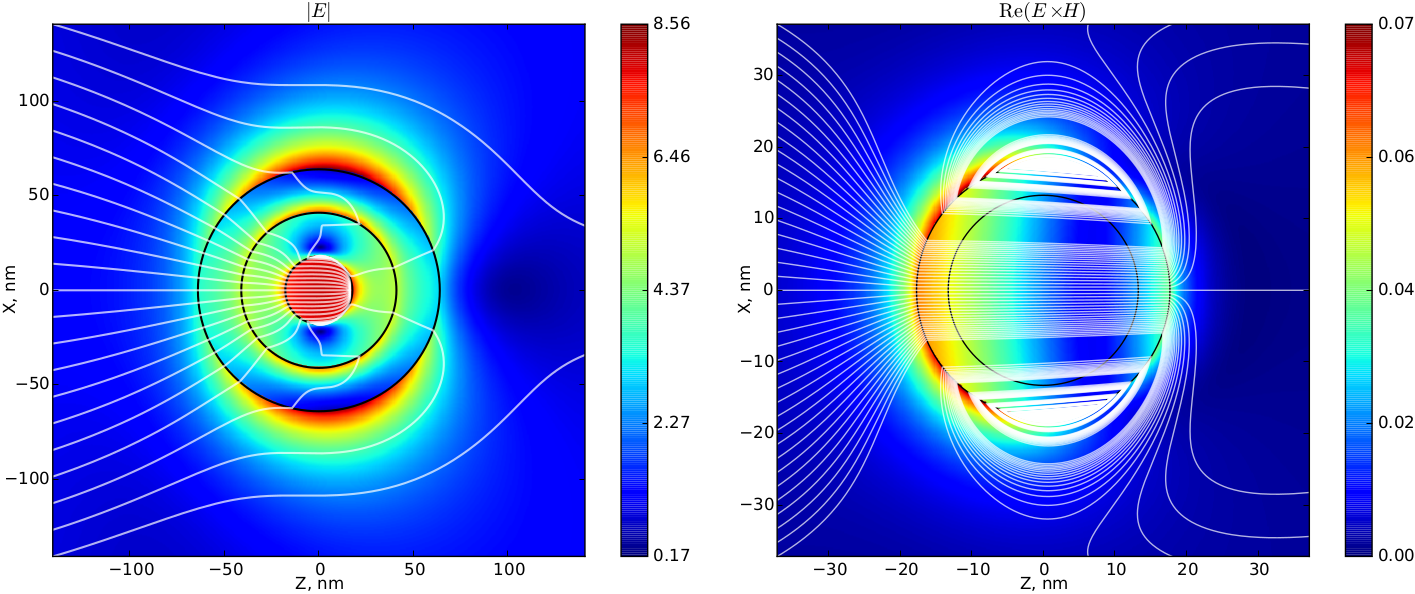README.md 6.5 KB
 Output example: Field distribution inside layered Si\Ag\Si sphere
and Poynting vector distribution in Ag sphere with powerflow lines
calculated with Scattnlay (scripts field-SiAgSi-flow.py and
field-Ag-flow.py from example section as revision ).
Output example: Field distribution inside layered Si\Ag\Si sphere
and Poynting vector distribution in Ag sphere with powerflow lines
calculated with Scattnlay (scripts field-SiAgSi-flow.py and
field-Ag-flow.py from example section as revision ).
Discuss:
Fill the issue here: Issues.
Stable releases
How to use scattnlay
Table of contents:
Mie theory calculator web application
Limited web version is available at https://physics.ifmo.ru/mie/
Compile Code
To compile the source you will need a C++11 capable compiler. To use optional MultiPrecision feature you need to install Boost.Multiprecision library (package names are given in Ubuntu\Debian notation):
- libboost-all-dev (>= 1.58.0)
To compile the Python extension you need NumPy:
- python-numpy (>= 1.0)
- python-all-dev (any version)
- python-numpy-dev (any version)
- pybind11 (any version)
And to compile the Debian package you need some tools:
- debhelper (>=7.0.0)
- dh-python (any version)
- cdbs (>= 0.4.49)
Compilation options
- make source - Create source package for Python extension
- make ext - Create Python extension using C++ code
- make install - Install Python extension on local system
- make rpm - Generate a rpm package for Python extension
- make deb - Generate a deb package for Python extension
- make standalone - Create standalone programs (scattnlay and fieldnlay)
- make clean - Delete temporal files
There are also an experimental CMake project and it is possible to compile into JavaScript module (using Emscripten compiler).
Python module
To build and install Python module run from the source code directory:
pip install . --user
Binary install
Binary files for Ubuntu and derivative distributions can be found at Launchpad To install it you must configure the repository:
sudo add-apt-repository ppa:ovidio/scattering
sudo apt update
and then you simply install the package:
sudo apt install python-scattnlay
You can also install it from PyPi via
sudo pip install python-scattnlay
You can also git clone and pip install -e . to develop python package.
Use
- Python library
- Use scattnlay directly
- Use scattnlay directly
from scattnlay import scattnlay, fieldnlay
...
x = ...
m = ...
coords = ...
terms, Qext, Qsca, Qabs, Qbk, Qpr, g, Albedo, S1, S2 = scattnlay(x, m)
terms, E, H = fieldnlay(x, m, coords)
...
- Execute some of the test scripts (located in the folder 'tests/python')
Example:
./test01.py
- Standalone program
- Execute scattnlay directly:
scattnlay -l Layers x1 m1.r m1.i [x2 m2.r m2.i ...] [-t ti tf nt] [-c comment]
- Execute fieldnlay directly:
fieldnlay -l Layers x1 m1.r m1.i [x2 m2.r m2.i ...] -p xi xf nx yi yf ny zi zf nz [-c comment]
- Execute some of the test scripts (located in the folder 'tests/shell'):
./test01.sh > test01.csv
- C++ library
Scattnlay "Hello world!" example:
try {
nmie::MultiLayerMieApplied<double> multi_layer_mie;
multi_layer_mie.AddTargetLayer(core_width, index_Si);
multi_layer_mie.AddTargetLayer(inner_width, index_Ag);
multi_layer_mie.AddTargetLayer(outer_width, index_Si);
multi_layer_mie.SetWavelength(WL);
multi_layer_mie.RunMieCalculation();
double Qabs = multi_layer_mie.GetQabs();
printf("Qabs = %g\n", Qabs);
} catch( const std::invalid_argument& ia ) {
// Will catch if multi_layer_mie fails or other errors.
std::cerr << "Invalid argument: " << ia.what() << std::endl;
return -1;
}
The complete example-minimal.cc and a bit more complicated
example-get-Mie.cc can be found in example directory along with
go-cc-examples.sh script with build commands.
example-get-Mie.cc can be compiled using double precision or
multiple precision (just include -DMULTI_PRECISION=200 to use 200
digits for calculations).
Related papers
O. Peña and U. Pal, "Scattering of electromagnetic radiation by a multilayered sphere," Comput. Phys. Commun. 180, 2348-2354 (2009). http://dx.doi.org/10.1016/j.cpc.2009.07.010
K. Ladutenko, O. Peña-Rodríguez, I. Melchakova, I. Yagupov and P. Belov, "Reduction of scattering using thin all-dielectric shells designed by stochastic optimizer," J. Appl. Phys. 116, 184508 (2014). http://dx.doi.org/10.1063/1.4900529
K. Ladutenko, P. Belov, O. Peña-Rodríguez, A. Mirzaei, A. Miroshnichenko and I. Shadrivov, "Superabsorption of light by nanoparticles," Nanoscale 7, 18897-18901 (2015). http://dx.doi.org/10.1039/C5NR05468K
K. Ladutenko, U. Pal, A. Rivera, and O. Peña-Rodríguez, "Mie calculation of electromagnetic near-field for a multilayered sphere," Comp. Phys. Comm. 214, 225-230 (2017). http://dx.doi.org/j.cpc.2017.01.017
Acknowledgment
We expect that all publications describing work using this software, or all commercial products using it, cite at least one of the following references:
[1] O. Peña and U. Pal, "Scattering of electromagnetic radiation
by a multilayered sphere," Computer Physics Communications, vol. 180, Nov. 2009, pp. 2348-2354.[2] K. Ladutenko, U. Pal, A. Rivera and O. Peña-Rodríguez, "Mie calculation
of electromagnetic near-field for a multilayered sphere," Computer Physics Communications, vol. 214, May 2017, pp. 225-230.
License
GPL v3+